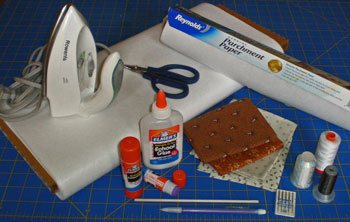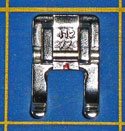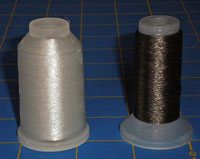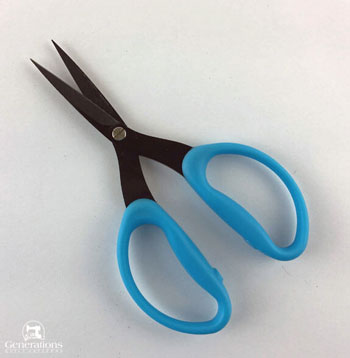- Home
- Machine Applique (Invisible)
- Applique Supplies
Applique Supplies
for Invisible Machine Applique
This post contains affiliate links, for which I receive compensation.
The applique supplies you need to create the "look" of hand applique stitched by machine are very basic.
Easily accessible.
In fact, most are probably sitting in your sewing room right now.
A quick trip to your local quilt store or grocery store is all that's needed to complete the list!

Invisible Machine Applique Supplies List
Required
- Sewing machine in good working order
- Open toe applique foot to see where the needle enters the fabric
- Zigzag stitch setting of 1.0 wide and 1.0 long
- Instruction manual
- Thread: Monofilament for the needle—;"I like YLI's Wonder Invisible Thread. 50 wt Cotton for the bobbin like Aurifil or Masterpiece that matches the background fabric
- Scissors for cutting fabric (I love my Perfect Scissors!)
- Elmer's Washable Glue Stick (I prefer the one that goes on purple/dries clear)
- Elmer's Glue (the white stuff in a bottle your kids use)
- Cuticle stick (a wooden skewer or orange stick also works)
- Iron and ironing surface (cover with fabric scraps or freezer paper to protect it)
- Pencil for tracing designs
- Microtex Sharp needles size 60/8 up to 75/11
Optional Applique Supplies
- Scissors for cutting paper
- Stapler and staples
- Cut and Press board for gluing/ironing templates
- Straight stitch throat plate
Right-click to download a PDF file of these applique supplies for a handy shopping list.
Now let's discuss some of the finer points of our applique supplies list...
What's an Open Toe Applique Foot?
 Open toe applique foot
Open toe applique footThe open toe applique foot differs from a standard presser foot.
- No bar joins the "toes" in front of the needle, so you can see better
- The bottom has a channel for stitching over raised pieces
If you can't find this foot, try a clear plastic presser foot.
As you stitch this type of applique, your eyes are focused directly where the needle pierces the fabric.
Anything and everything you can do to make it easier to see makes for a much more enjoyable time at your sewing machine.
Click here to find one for your machine if you don't have one.
The ZigZag Stitch Requirements
You need a sewing machine with a zigzag stitch that can be adjusted to 0.5 to 1.0 wide and 1.0 long.
For this set up your zig zag throat plate will work just fine. It's the one with an oval opening.
Straight Stitch Throat Plate - Optional
A straight stitch throat plate has a much smaller hole. Smaller hole means better stitch quality and less chance of fabric jamming while stitching.
If you already have a straight stitch throat plate, then test it as follows:
- Install the straight stitch throat plate
- Set the zigzag to 1.0 wide and 1.0 long
- Hand walk the unthreaded machine through a couple of stitches—if the hole is too small you won't break a needle. If the needle hits the throat plate, then stop now and just use the zigzag version (oval hole) throatplate. Otherwise...
- Thread the needle and using a practice applique piece, again, hand walk your machine through several stitches. If this works, then do use this throat plate.
Why bother messing around with this?
A smaller hole in the throatplate means there's less chance of the fabric getting pushed through the hole.
This makes for better stitch quality in general.
So What's the Secret Ingredient?
Rinsaway water soluble stabilizer!
Made of polyester, it's washable and comes in 20 inch wide yardage.
Big box stores will carry it for about $2/yard. You will use it straight from the bolt or from the package. There's no need to pre-wash or pre-treat.
This water soluble stabilizer tears like heavy paper.
But wash it and it turns into polyester fibers. With freezer paper templates, you must remove the template (usually by cutting it out from behind). But this method creates...
Applique templates you leave in the quilt!
The fibers are soft once your block is washed and all the glue removed. If you didn't know there was fiber in your applique shapes, you wouldn't know there was fiber in your applique.
Great stuff!
Get the Right Monofilament Thread
 YLI Monofilament Thread Clear (l)
looks milky on the spool and Smoke(r)
YLI Monofilament Thread Clear (l)
looks milky on the spool and Smoke(r)Use a quality monofilament thread (size .004) for invisible machine applique. It's soft and supple.
The one I always use is YLI's Wonder Invisible Thread. It's made of nylon which means reduce your iron temperature when pressing stitched applique shapes.
Sulky and Superior Threads (MonoPoly) both make polyester monofilament thread.
Polyester has a higher melting point than nylon. Check your local quilt store for these threads.
Monofilament thread comes in:
- Clear (appears "milky" on the spool) for stitching on light, bright or clear colors, and...
- Smoke for stitching on dark, shaded or country colors
While clear works for most colors, I keep and use both.
For the bobbin, a 50 wt, 100% cotton thread like Aurifil or Superior Threads' Masterpiece will balance nicely with the monofilament.
Why Elmer's?
Elmer's Washable School Glue Stick and white School Glue are available everywhere and used by everyone. They are non-toxic, acid-free, washable and CHEAP.
I keep both the small and large glue sticks on hand.
You can certainly use other fabric glues but they MUST completely wash out of the fabric. That is crucial.
I stock up every year on these during the 'Back to School' sales in the fall.
Fabric Preparation
Pre-wash or preshrink only the quilt fabric for the applique pieces.
Then pretest all the fabrics, including the background, to make sure they don't bleed or crock. (Click to learn how to do a bleed test.)
Your block is washed in the final step to remove all the glue. The background fabric shrinks a bit then. That shrinkage pulls in the stitching on the applique shapes just a bit to further.
The result is stitches that are nearly invisible.
That completes our "Applique Supplies" list and descriptions. Let's move on to creating our applique templates.




